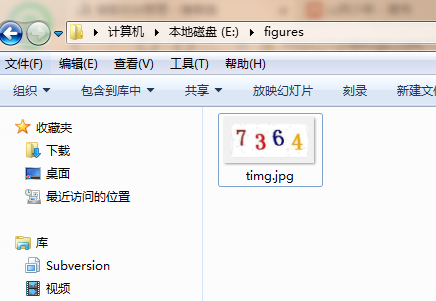OCR与Tesseract介绍
将图片翻译成文字一般被称为光学文字识别(Optical Character Recognition,OCR)。可以实现OCR 的底层库并不多,目前很多库都是使用共同的几个底层OCR 库,或者是在上面进行定制。
Tesseract 是一个OCR 库,目前由Google 赞助(Google 也是一家以OCR 和机器学习技术闻名于世的公司)。Tesseract 是目前公认最优秀、最精确的开源OCR 系统。
除了极高的精确度,Tesseract 也具有很高的灵活性。它可以通过训练识别出任何字体(只要这些字体的风格保持不变就可以),也可以识别出任何Unicode 字符。
Tesseract的安装与使用
Tesseract的Windows安装包下载地址为: http://digi.bib.uni-mannheim.de/tesseract/tesseract-ocr-setup-4.00.00dev.exe ,下载后双击直接安装即可。安装完后,需要将Tesseract添加到系统变量中。在CMD中输入tesseract -v, 如显示以下界面,则表示Tesseract安装完成且添加到系统变量中。
识别简体中文,需要事先安装简体中文语言包,下载地址为:https://github.com/tesseract-ocr/tessdata/find/master/chi_sim.traineddata ,再讲chi_sim.traineddata放在C:\Program Files (x86)\Tesseract-OCR\tessdata目录下。
Python图像处理之图片验证码识别
利用Tesseract软件来识别图片中的英文与中文,本文将具体介绍如何在Python中利用Tesseract软件来识别验证码(数字加字母)。
本文将具体介绍如何利用Python的图像处理模块pillow和OCR模块pytesseract来识别上述验证码(数字加字母)。
我们识别上述验证码的算法过程如下:
-
- 将原图像进行灰度处理,转化为灰度图像;
- 获取图片中像素点数量最多的像素(此为图片背景),将该像素作为阈值进行二值化处理,将灰度图像转化为黑白图像(用来提高识别的准确率);
- 去掉黑白图像中的噪声,噪声定义为:以该点为中心的九宫格的黑点的数量小于等于4;
- 利用pytesseract模块识别,去掉识别结果中的特殊字符,获得识别结果。
完整的Python代码如下:
import os
import pytesseract
from PIL import Image
from collections import defaultdict
# tesseract.exe所在的文件路径
pytesseract.pytesseract.tesseract_cmd = 'C://Program Files (x86)/Tesseract-OCR/tesseract.exe'
# 获取图片中像素点数量最多的像素
def get_threshold(image):
pixel_dict = defaultdict(int)
# 像素及该像素出现次数的字典
rows, cols = image.size
for i in range(rows):
for j in range(cols):
pixel = image.getpixel((i, j))
pixel_dict[pixel] += 1
count_max = max(pixel_dict.values()) # 获取像素出现出多的次数
pixel_dict_reverse = {v: k for k, v in pixel_dict.items()}
threshold = pixel_dict_reverse[count_max] # 获取出现次数最多的像素点
return threshold
# 按照阈值进行二值化处理
# threshold: 像素阈值
def get_bin_table(threshold):
# 获取灰度转二值的映射table
table = []
for i in range(256):
rate = 0.1 # 在threshold的适当范围内进行处理
if threshold * (1 - rate) <= i <= threshold * (1 + rate):
table.append(1)
else:
table.append(0)
return table
# 去掉二值化处理后的图片中的噪声点
def cut_noise(image):
rows, cols = image.size # 图片的宽度和高度
change_pos = [] # 记录噪声点位置
# 遍历图片中的每个点,除掉边缘
for i in range(1, rows - 1):
for j in range(1, cols - 1):
# pixel_set用来记录该店附近的黑色像素的数量
pixel_set = []
# 取该点的邻域为以该点为中心的九宫格
for m in range(i - 1, i + 2):
for n in range(j - 1, j + 2):
if image.getpixel((m, n)) != 1: # 1为白色,0位黑色
pixel_set.append(image.getpixel((m, n)))
# 如果该位置的九宫内的黑色数量小于等于4,则判断为噪声
if len(pixel_set) <= 4:
change_pos.append((i, j))
# 对相应位置进行像素修改,将噪声处的像素置为1(白色)
for pos in change_pos:
image.putpixel(pos, 1)
return image # 返回修改后的图片
# 识别图片中的数字加字母
# 传入参数为图片路径,返回结果为:识别结果
def OCR_lmj(img_path):
image = Image.open(img_path) # 打开图片文件
imgry = image.convert('L') # 转化为灰度图
# 获取图片中的出现次数最多的像素,即为该图片的背景
max_pixel = get_threshold(imgry)
# 将图片进行二值化处理
table = get_bin_table(threshold=max_pixel)
out = imgry.point(table, '1')
# 去掉图片中的噪声(孤立点)
out = cut_noise(out)
# 保存图片
# out.save('E://figures/img_gray.jpg')
# 仅识别图片中的数字
# text = pytesseract.image_to_string(out, config='digits')
# 识别图片中的数字和字母
text = pytesseract.image_to_string(out)
# 去掉识别结果中的特殊字符
exclude_char_list = ' .:\\|\'\"?![],()~@#$%^&*_+-={};<>/¥'
text = ''.join([x for x in text if x not in exclude_char_list])
# print(text)
return text
def main():
# 识别指定文件目录下的图片
# 图片存放目录figures
dir = 'E://figures'
correct_count = 0 # 图片总数
total_count = 0 # 识别正确的图片数量
# 遍历figures下的png,jpg文件
for file in os.listdir(dir):
if file.endswith('.png') or file.endswith('.jpg'):
# print(file)
image_path = '%s/%s' % (dir, file) # 图片路径
answer = file.split('.')[0] # 图片名称,即图片中的正确文字
recognizition = OCR_lmj(image_path) # 图片识别的文字结果
print((answer, recognizition))
if recognizition == answer: # 如果识别结果正确,则total_count加1
correct_count += 1
total_count += 1
print('Total count: %d, correct: %d.' % (total_count, correct_count))
'''
# 单张图片识别
image_path = 'E://figures/code .jpg'
OCR_lmj(image_path)
'''
if __name__:
main()运行结果如下:

来源:oschina
链接:https://my.oschina.net/u/4336077/blog/3408428
